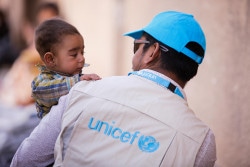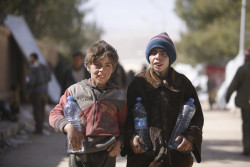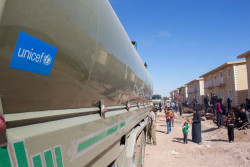メニュー 閉じる
- TOP
- はじめてのかたへ
- よくあるご質問/お問合せ
-
ユニセフについて
-
世界の子どもたちを知る
-
ユニセフハウス展示見学
- 協定地域組織(地域における活動)
- イベント一覧
- お知らせ一覧
- ご支援者(個人)の皆様へ
ユニセフについて
世界の子どもたちを知る
ユニセフハウス展示見学
 寄付方法のご案内
寄付方法のご案内
 ご寄付による支援例・成果
ご寄付による支援例・成果
 領収書
領収書
 その他のご協力方法
その他のご協力方法
 個人のみなさま
個人のみなさま
 学校・園のみなさま
学校・園のみなさま
 大学生ボランティア
大学生ボランティア
【2018年4月10日 ジュネーブ発】
 |
|
© UNICEF/UN0187723/Sanadiki |
|
ユニセフの子どもの保護専門官に抱かれる生後6カ月のユスフ君。(2018年3月20日撮影) |
本日、国連ジュネーブ事務所の定例記者ブリーフィングで、ユニセフ(国連児童基金)ジュネーブの広報官クリストフ・ブリエラックが報告した、シリアのアフリンおよび東グータの子どもたちの最新状況を抜粋してお伝えします。
* * *
 |
|
© UNICEF/UN0187722/Sanadiki |
|
給水車から水を汲み、運ぶ子どもたち。(2018年3月20日撮影) |
3月9日以降に東グータから退避した国内避難民(IDP)の数は13万にのぼり、その50%は子どもと推定されます。ダマスカス郊外県の国内避難民用の避難所には、8万9,683人が到着し、4月9日時点で留まっている人数は4万4,667人です。さらにこの数週間で、5万人以上の兵士とその家族がシリア北西部に移送されました。
ユニセフは、東グータからの国内避難民を受け入れている集合避難所に対して、分野横断型の支援を通じて子どもたちと家族に提供し続けています。
ユニセフが実施している子どもたちと家族への支援には以下のことが含まれます。
 |
|
© UNICEF/UN0186371/Abdulmunem |
|
集合型シェルターに水を運ぶ給水車。(2018年3月17日撮影) |
1月20日に勃発したアレッポ州アフリン地区での軍事衝突により、推計13万7,070人がTall Refaat、Nabul とZahraa、 Fafinや周辺の村々に避難しました。約5万人から7万人が今もアフリン市内に残っていると考えられています。国連機関等が実施した最近の現地での評価調査に基づき、国内避難民数の推計は前回より下方修正されています。国内避難民の多く(9万250人)は現在Tall Refaatと周辺の10の村々に避難しており、2万人がNabulに、1万人がZahraaに、1万5,000人がKafr Naseh および Fafinに避難しています。
Tall Refaatに避難している人々のほとんどは、廃墟に暮らし、ひと部屋に数家族が暮らしていることも珍しくありません。モスクや学校に滞在している家族や、野宿している家族もいます。NabulとZahraaに逃れた国内避難民は、モスクや集会所などの集合避難所に滞在しているか、家を借りて住んでいます。
ユニセフは、シリア・アラブ赤新月社を通じて、Fafinの避難民キャンプとFafin村の集合避難所それぞれに給水車40台分の5,000リットルの水を提供しました。加えて、給水車を使って1日200立方メートルの飲料水を約1万5,000人の人々に提供し続けています。同時に、NubulとZahraa に加えてTal Refaatと周辺地域にも給水車を使って、1,000立方メートルの水を約6万5,000人の国内避難民に提供しています。
診療所および移動診療チームは、何千人もの子どもと女性に保健・栄養支援を提供しています。Tal Rafaatでは、約4,500人の子どもにプライマリー・ヘルスケアを提供しました。定期予防接種ならびに栄養状態検査は3カ所すべてで継続して行っています。
ユニセフは、Tal Rafaatとその周辺の村々の1,000人に対して、子どもの保護、心理社会ケア、危険回避教育を含む保護ケアの提供ならびに支援のケースマネージメントも行っています。ユニセフは、Tal Refaatの子ども1万人が危険回避教育を受けるために十分な支援物資を国連の人道支援物資車列に載せて届けました。
【関連ページ】
シェアする
